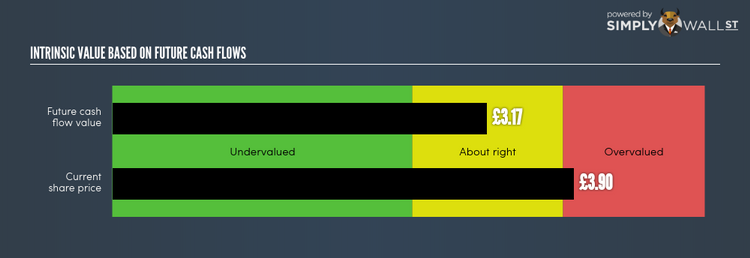Intrinsic Calculation For Ashmore Group PLC (LON:ASHM) Shows Investors Are Overpaying

Pricing ASHM, a financial stock, can be difficult since these capital market businesses have cash flows that are affected by regulations that are not imposed upon other sectors. For instance, these businesses must hold a certain level of cash reserves on the books as a safety precaution. Examining line items like book values, along with the return and cost of equity, is practical for assessing ASHM’s value. Today I will show you how to value ASHM in a relatively useful and straightforward way. Check out our latest analysis for Ashmore Group
Why Excess Return Model?
Let’s keep in mind two things – regulation and type of assets. The regulatory environment in United Kingdom is fairly rigorous. In addition to this, capital markets tend to not hold substantial amounts of physical assets on their balance sheet. The Excess Returns model overcomes the required capital kept on hand and lack of tangibles by focusing on forecasting stable earnings, rather than less relevant factors such as depreciation and capex, which more traditional models focus on.
Deriving ASHM’s Intrinsic Value
The main assumption for Excess Returns is that equity value is how much the firm can earn, over and above its cost of equity, given the level of equity it has in the company at the moment. The returns above the cost of equity is known as excess returns:
Excess Return Per Share = (Stable Return On Equity – Cost Of Equity) (Book Value Of Equity Per Share)
= (21.66% – 9.04%) * £1.19 = £0.15
Excess Return Per Share is used to calculate the terminal value of ASHM, which is how much the business is expected to continue to generate over the upcoming years, in perpetuity. This is a common component of discounted cash flow models:
Terminal Value Per Share = Excess Return Per Share / (Cost of Equity – Expected Growth Rate)
= £0.15 / (9.04% – 1.49%) = £1.98
Putting this all together, we get the value of ASHM’s share:
Value Per Share = Book Value of Equity Per Share + Terminal Value Per Share
= £1.19 + £1.98 = £3.17
Given ASHM’s current share price of £3.9, ASHM is priced above its true value. This means there’s no upside in buying ASHM at its current price. Valuation is only one side of the coin when you’re looking to invest, or sell, ASHM. Analyzing fundamental factors are equally important when it comes to determining if ASHM has a place in your holdings.
Next Steps:
For capital markets, there are three key aspects you should look at:
Financial health: Does it have a healthy balance sheet? Take a look at our free bank analysis with six simple checks on things like leverage and risk.
Future earnings: What does the market think of ASHM going forward? Our analyst growth expectation chart helps visualize ASHM’s growth potential over the upcoming years.
Dividends: Most people buy financial stocks for their healthy and stable dividends. Check out whether ASHM is a dividend Rockstar with our historical and future dividend analysis.
For more details and sources, take a look at our full calculation on ASHM here.
To help readers see pass the short term volatility of the financial market, we aim to bring you a long-term focused research analysis purely driven by fundamental data. Note that our analysis does not factor in the latest price sensitive company announcements.
The author is an independent contributor and at the time of publication had no position in the stocks mentioned.

